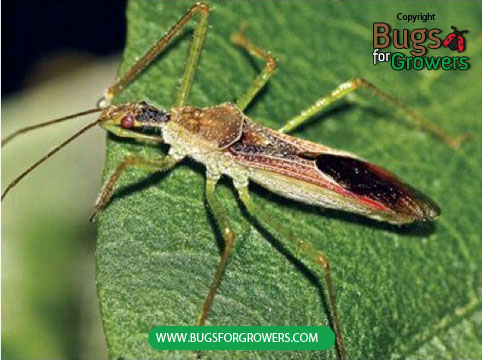What are assassin bugs?
Predatory Assassin bugs (Zelus renardii) are kind of stink bugs that have piercing and sucking types of mouthparts that look like beaks of birds. Adult assassin bugs are about 1/2 to 3/4 inch long and blackish to brownish in color with red eyes (Photo 1). Female bugs generally lay eggs in clusters on the leaves or in the soil. These eggs hatch within a week into small wingless nymphs that look like their parents.

How assassin bugs kill their insect hosts?
Predatory assassin bugs are supplied as eggs or nymphs that are released in the fields or greenhouses to target insect pests. These released nymphs will walk quickly from plant to plant and actively search for insect host stages including larvae, caterpillars, grubs and pupae, and all the stages of aphids. Once they find these host stages, both nymphs and adults of assassin bugs will use their beaks to puncture and paralyze them and then suck their body content until they are killed.
Following twelve insect pests are killed by predatory assassin bugs
Predatory assassin bugs are considered as the most effective biological control agents because they can kill and feed on immature stages of following twelve different insect pests that are responsible for causing serious damage to many agricultural and horticultural crops and ornamental plants.
Names of twelve insect pests and their stages killed by assassin bugs
- Aphids : Adults and nymphs
- Armyworms : Larvae and pupae
- Cabbage looper, Trichoplusia ni : Larvae and pupae
- Cabbage worm, Pieris brassicae: Larvae and pupae
- May beetles: Grubs and pupae
- Diamondback moth, Plutella xylostella : Larvae and pupae
- Fall armyworm, Spodoptera frugiperda : Larvae and pupae
- Flea beetles : Grubs and pupae
- Imported cabbage worm, Pieris rapae : Larvae and pupae
- Leaf beetles : Grubs and pupae
- The Poinciana Looper : Larvae and pupae
- Oakworm : Larvae
When and how many assassin bugs should be released for effective control of insect pests?
- When there is a low infestation of target insect pests, release 500 eggs of assassin bugs per 2000 to 3000 sq.ft. area every 2-3 weeks.
- When there is a heavy infestation of target insect pests, release 500- 1000 eggs of assassin bugs per 2000 to 3000 sq.ft. area weekly.
